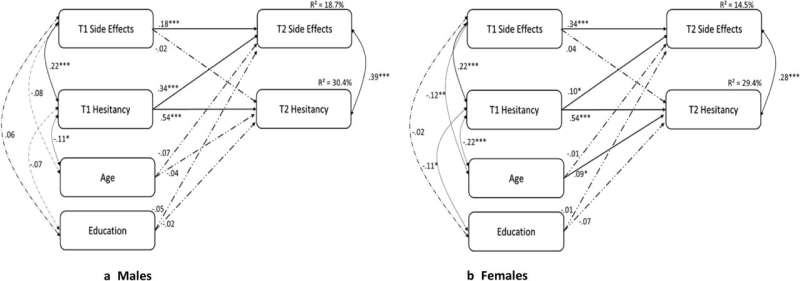Testing the nocebo effect: Vaccine hesitancy predicts future COVID-19 vaccine side effects

While the production of COVID vaccines could have been the "light at the end of the pandemic tunnel," this outcome was hampered at critical stages by vaccine hesitancy, defined by the World Health Organization (WHO) as "the reluctance or refusal to vaccinate despite the availability of vaccines."
Even prior to COVID-19, the WHO considered vaccine hesitancy to be one of the 10 global threats to public health. It has become even more critical in the COVID-19 context. Vaccine hesitancy often results in vaccination after weighing the pro and cons, and is different than an antivax stance, which usually leads to vaccine refusal and is motivated in large part by ideological, political and religious reasons. Both vaccine hesitancy and antivax positions are fueled by inaccurate or exaggerated reports of vaccine side effects.
The precise relationship between vaccine hesitancy and COVID-19 vaccination side effects has not previously been explored in vaccinated persons. A fundamental question arises in regard to the directionality of this vaccine hesitancy-vaccine side effect link, namely which variable predicts which.
One possibility is that side effects from an earlier dose predict one's vaccine hesitancy towards a later dose. Alternatively, one's psychological negativity (hesitancy) towards an earlier dose could predict subsequent side effects from a later vaccination dose. The latter direction reflects a nocebo effect, i.e., side effects driven by psychological factors rather than by an active treatment component.
The unique, contiguous waves of COVID-19 vaccinations have presented a rare opportunity to test the nocebo effect on vaccinated individuals. In a new study, researchers from Bar-Ilan University and Ariel University in Israel examined this issue in 750 older adults. Older adults are advantageous as they have a high vaccination rate coupled with low side effects, rendering detection of such nocebo effects more challenging.
To address this issue, one needs to assess both variables (vaccine hesitancy and side effects) at two different time points (after the second vaccination dose and six months later after the booster dose) and examine if wave-1 side effects predict wave-2 hesitancy, or whether wave-1 hesitancy predicts wave-2 side-effects. This design is very conservative, and the statistical threshold for such effects is conceptually high, as such effects have to hold beyond all other effects.
Results showed only the latter direction to be true. Namely, only earlier vaccine hesitancy towards the second COVID-19 dose predicted subsequent nocebo side-effects following the booster vaccination. To put this in perspective up to 16% of one's vaccine side effects were explained by earlier vaccine hesitancy. Supplementary analyses revealed that results held beyond specific side effects and vaccine-hesitancy items.
Typical of nocebo effects, compatible gender differences were observed. For example, the nocebo effect in females is more impacted by previous experience. Following, the link between previous side effects and current side effects, was twice as large in females versus males.
Beyond the theoretical importance of demonstrating a mind-over-matter effect, these data are novel in additional aspects. First, they provide a precise (even if underestimated) magnitude of the nocebo effect in vaccinated persons. This is not trivial as other methods of estimating such nocebo-effects typically rely on a statistical assumption that has been challenged, namely, that nocebo effects are additive (constant in treatment groups and non-treatment groups).
Second, public health messaging is typically geared towards unvaccinated persons, stressing that the vaccine is safe. "Such public health messaging may for example be less suited to those who received a vaccination dose and have electively chosen to discontinue vaccination. In the United States alone there are over 150 million such persons," says Prof. Yaakov Hoffman, from the Interdisciplinary Department of Social Sciences at Bar-Ilan University, who was the lead author of a study just published in the journal Scientific Reports.
"For such persons messaging focused on general vaccination safety may be less applicable to partially-vaccinated individuals who have first-hand experience with vaccine side effects and electively chose to discontinue vaccination. Rather differentiated public health messaging is required," added co-author Prof. Menachem Ben-Ezra, of Ariel University.
The study reveals different risk levels, and therefore different types of messaging may be tailored to different risk levels. For instance, low-risk individuals (older adults, males, low vaccine hesitancy) may benefit from messaging highlighting that for "them" the vaccine is even safer than for the general-public. Yet for those at high-risk levels (younger adults, females, high hesitancy), a public health message focusing on the notion that a significant portion of their side effects doesn't stem from the treatment (vaccine) may be more beneficial.
Conveying that COVID-19 vaccine side effects may be driven by anxiety or a previous negative expectation may be extremely effective. Such messaging should be coupled with nocebo education conveying that these experienced side effects are just as physically real, yet may not stem from treatment but from other factors. The current results, indicating that vaccination side effects comprise nocebo effects, seem to be an important factor that can effectively facilitate public health messaging if it is conveyed in an accepting, humane and non-paternalistic manner.
Such messaging should reduce the nocebo effect, and in turn lower vaccination side effects. The researchers suggest that this would not only mitigate one's suffering from side effects but also impact the macro level, as if side effects diminish, there will be less support for overall antivax campaigns,
These findings may bear on other vaccinations that aren't given in contiguous waves and thus cannot be examined in the above fashion. "Most importantly, as COVID-19 may still be a threat and vaccines are still offered, public health messaging should consider addressing the issue that side-effects comprise a nocebo component," says Hoffman.
More information: Yaakov S. G. Hoffman et al, Vaccine hesitancy prospectively predicts nocebo side-effects following COVID-19 vaccination, Scientific Reports (2022). DOI: 10.1038/s41598-022-21434-7


















